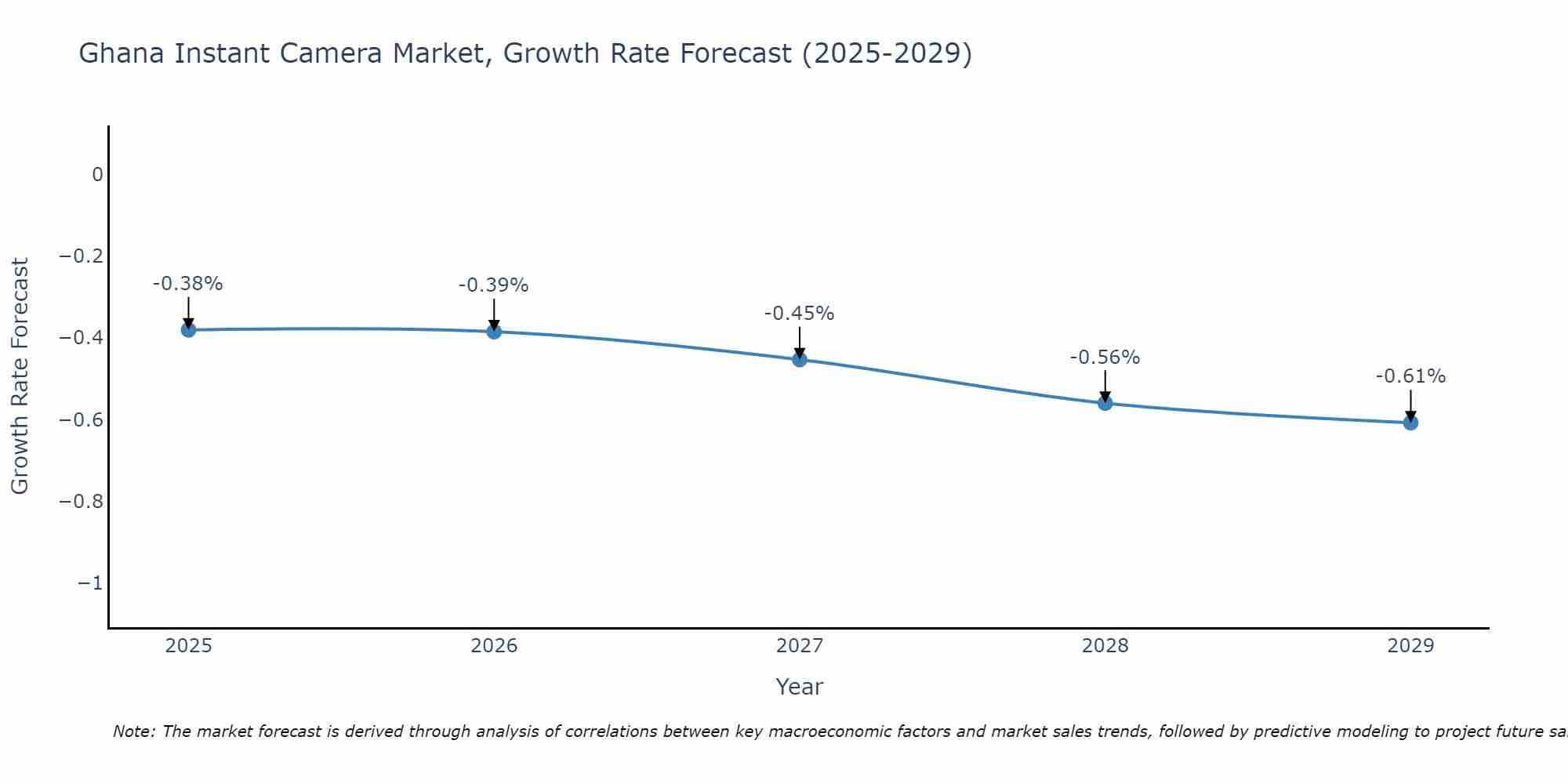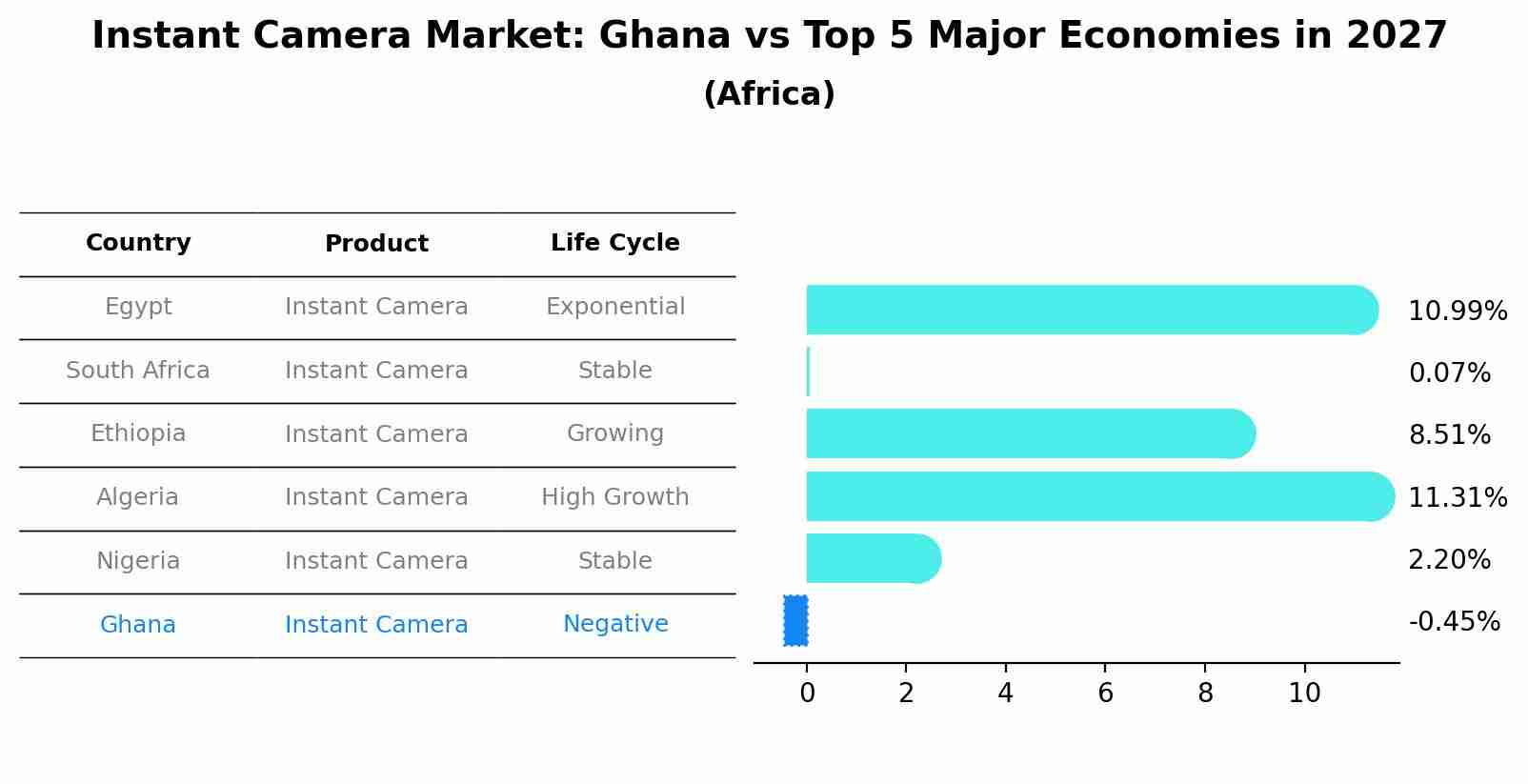Ghana Instant Camera Market (2025-2031) Outlook | Industry, Analysis, Companies, Growth, Trends, Forecast, Value, Share, Size & Revenue
| Product Code: ETC365576 | Publication Date: Aug 2022 | Updated Date: Aug 2025 | Product Type: Market Research Report | |
| Publisher: 6Wresearch | Author: Bhawna Singh | No. of Pages: 75 | No. of Figures: 35 | No. of Tables: 20 |
Ghana Instant Camera Market Size Growth Rate
The Ghana Instant Camera Market may undergo a gradual slowdown in growth rates between 2025 and 2029. Beginning strongly at -0.38% in 2025, growth softens to -0.61% in 2029.

Instant Camera Market: Ghana vs Top 5 Major Economies in 2027 (Africa)
The Instant Camera market in Ghana is projected to grow at a negative growth rate of -0.45% by 2027, within the Africa region led by Egypt, along with other countries like South Africa, Ethiopia, Algeria and Nigeria, collectively shaping a dynamic and evolving market environment driven by innovation and increasing adoption of emerging technologies.

Ghana Instant Camera Market Synopsis
The Ghana instant camera market is experiencing growth driven by a combination of nostalgia for analog photography and the desire for immediate photo prints. Popular brands like Fujifilm Instax and Polaroid dominate the market, offering a range of instant cameras catering to different consumer preferences. The market is fueled by a growing interest in capturing and sharing physical memories in a digital age. Key factors influencing consumer purchasing decisions include affordability, ease of use, and design aesthetics. Retailers and e-commerce platforms play a crucial role in distributing instant cameras to a diverse consumer base in urban and rural areas of Ghana. As social media continues to influence photography trends, the instant camera market in Ghana is poised for further expansion and innovation to meet the evolving needs of consumers.
Ghana Instant Camera Market Trends
The Ghana Instant Camera Market is experiencing a surge in popularity driven by the growing trend of nostalgia and retro photography. Consumers are increasingly seeking tangible and instant prints in the digital age, leading to a higher demand for instant cameras. Additionally, social media has played a significant role in popularizing instant photography as users look for unique and authentic ways to capture and share moments. Key players in the market are responding to this trend by introducing innovative features such as improved image quality, creative shooting modes, and compact designs to cater to the evolving needs of consumers. The market is expected to continue growing as more individuals embrace the joy of instant photography and seek to create physical memories in a fast-paced digital world.
Ghana Instant Camera Market Challenges
In the Ghana Instant Camera Market, some challenges faced include limited disposable income among consumers, high import taxes on electronic products, and competition from smartphone cameras offering similar instant photo capabilities. Additionally, the lack of widespread availability of film for instant cameras and the need for constant innovation to stay relevant in a rapidly evolving technology landscape pose significant challenges for companies operating in this market. To succeed in Ghana`s Instant Camera Market, companies need to adapt their products to suit the local market preferences, establish efficient distribution channels, and invest in marketing efforts to educate consumers about the value proposition of instant cameras over other alternatives.
Ghana Instant Camera Market Investment Opportunities
The Ghana Instant Camera Market presents promising investment opportunities driven by the growing interest in photography among the younger population and the trend towards nostalgia and retro products. With the rise of social media platforms like Instagram, there is a demand for instant print cameras that offer physical copies of photos for sharing and decoration. Investing in this market could involve partnering with camera manufacturers to introduce new and innovative instant camera models tailored to the preferences of Ghanaian consumers, as well as developing marketing strategies that target the youth demographic. Additionally, investing in retail channels and distribution networks to make instant cameras more accessible across various regions in Ghana could also yield significant returns in this emerging market segment.
Jordan Agar Market Government Policies
Government policies related to the Ghana Instant Camera Market include import tariffs on cameras and related accessories, which may impact the cost and availability of instant cameras in the country. Additionally, there are regulations on the sale and distribution of electronic devices that may affect the marketing and sales strategies of instant camera manufacturers and retailers. The government also promotes local manufacturing and entrepreneurship through various incentives and support programs, which could potentially impact the market dynamics for instant cameras in Ghana. Overall, understanding and complying with these government policies is essential for businesses operating in the Ghana Instant Camera Market to navigate the regulatory landscape and optimize their market strategies.
Ghana Instant Camera Market Future Outlook
The future outlook for the Ghana Instant Camera Market looks promising with a projected growth in demand fueled by increasing social media usage and the rising trend of capturing and sharing instant moments. As consumers seek more tangible and nostalgic experiences in the digital age, instant cameras provide a unique blend of convenience and creativity. Additionally, the market is likely to benefit from a growing interest in photography among the younger demographic and the popularity of instant prints for events and gatherings. Manufacturers are expected to introduce innovative features and designs to cater to evolving consumer preferences, further driving market expansion. Overall, the Ghana Instant Camera Market is poised for steady growth in the coming years as it continues to appeal to a diverse range of consumers looking for instant gratification and creativity in photography.
Key Highlights of the Report:
- Ghana Instant Camera Market Outlook
- Market Size of Ghana Instant Camera Market, 2024
- Forecast of Ghana Instant Camera Market, 2031
- Historical Data and Forecast of Ghana Instant Camera Revenues & Volume for the Period 2021 - 2031
- Ghana Instant Camera Market Trend Evolution
- Ghana Instant Camera Market Drivers and Challenges
- Ghana Instant Camera Price Trends
- Ghana Instant Camera Porter's Five Forces
- Ghana Instant Camera Industry Life Cycle
- Historical Data and Forecast of Ghana Instant Camera Market Revenues & Volume By Type for the Period 2021 - 2031
- Historical Data and Forecast of Ghana Instant Camera Market Revenues & Volume By Non-retractable Lenses Instant Camera for the Period 2021 - 2031
- Historical Data and Forecast of Ghana Instant Camera Market Revenues & Volume By Retractable Lenses Instant Camera for the Period 2021 - 2031
- Historical Data and Forecast of Ghana Instant Camera Market Revenues & Volume By Distribution Channel for the Period 2021 - 2031
- Historical Data and Forecast of Ghana Instant Camera Market Revenues & Volume By Offline for the Period 2021 - 2031
- Historical Data and Forecast of Ghana Instant Camera Market Revenues & Volume By Online for the Period 2021 - 2031
- Historical Data and Forecast of Ghana Instant Camera Market Revenues & Volume By Application for the Period 2021 - 2031
- Historical Data and Forecast of Ghana Instant Camera Market Revenues & Volume By Commercial Use for the Period 2021 - 2031
- Historical Data and Forecast of Ghana Instant Camera Market Revenues & Volume By Individual Use for the Period 2021 - 2031
- Ghana Instant Camera Import Export Trade Statistics
- Market Opportunity Assessment By Type
- Market Opportunity Assessment By Distribution Channel
- Market Opportunity Assessment By Application
- Ghana Instant Camera Top Companies Market Share
- Ghana Instant Camera Competitive Benchmarking By Technical and Operational Parameters
- Ghana Instant Camera Company Profiles
- Ghana Instant Camera Key Strategic Recommendations
Frequently Asked Questions About the Market Study (FAQs):
- Single User License$ 1,995
- Department License$ 2,400
- Site License$ 3,120
- Global License$ 3,795
Search
Thought Leadership and Analyst Meet
Our Clients
Related Reports
- Canada Oil and Gas Market (2026-2032) | Share, Segmentation, Value, Industry, Trends, Forecast, Analysis, Size & Revenue, Growth, Competitive Landscape, Outlook, Companies
- Germany Breakfast Food Market (2026-2032) | Industry, Share, Growth, Size, Companies, Value, Analysis, Revenue, Trends, Forecast & Outlook
- Australia Briquette Market (2025-2031) | Growth, Size, Revenue, Forecast, Analysis, Trends, Value, Share, Industry & Companies
- Vietnam System Integrator Market (2025-2031) | Size, Companies, Analysis, Industry, Value, Forecast, Growth, Trends, Revenue & Share
- ASEAN and Thailand Brain Health Supplements Market (2025-2031) | Strategy, Consumer Insights, Analysis, Investment Trends, Opportunities, Growth, Size, Share, Industry, Revenue, Segments, Value, Segmentation, Supply, Forecast, Restraints, Outlook, Competition, Drivers, Trends, Demand, Pricing Analysis, Competitive, Strategic Insights, Companies, Challenges
- ASEAN Bearings Market (2025-2031) | Strategy, Consumer Insights, Analysis, Investment Trends, Opportunities, Growth, Size, Share, Industry, Revenue, Segments, Value, Segmentation, Supply, Forecast, Restraints, Outlook, Competition, Drivers, Trends, Demand, Pricing Analysis, Competitive, Strategic Insights, Companies, Challenges
- Europe Flooring Market (2025-2031) | Outlook, Share, Industry, Trends, Forecast, Companies, Revenue, Size, Analysis, Growth & Value
- Saudi Arabia Manlift Market (2025-2031) | Outlook, Size, Growth, Trends, Companies, Industry, Revenue, Value, Share, Forecast & Analysis
- Uganda Excavator, Crane, and Wheel Loaders Market (2025-2031) | Strategy, Consumer Insights, Analysis, Investment Trends, Opportunities, Growth, Size, Share, Industry, Revenue, Segments, Value, Segmentation, Supply, Forecast, Restraints, Outlook, Competition, Drivers, Trends, Demand, Pricing Analysis, Competitive, Strategic Insights, Companies, Challenges
- Rwanda Excavator, Crane, and Wheel Loaders Market (2025-2031) | Strategy, Consumer Insights, Analysis, Investment Trends, Opportunities, Growth, Size, Share, Industry, Revenue, Segments, Value, Segmentation, Supply, Forecast, Restraints, Outlook, Competition, Drivers, Trends, Demand, Pricing Analysis, Competitive, Strategic Insights, Companies, Challenges
Industry Events and Analyst Meet
Whitepaper
- Middle East & Africa Commercial Security Market Click here to view more.
- Middle East & Africa Fire Safety Systems & Equipment Market Click here to view more.
- GCC Drone Market Click here to view more.
- Middle East Lighting Fixture Market Click here to view more.
- GCC Physical & Perimeter Security Market Click here to view more.
6WResearch In News
- Doha a strategic location for EV manufacturing hub: IPA Qatar
- Demand for luxury TVs surging in the GCC, says Samsung
- Empowering Growth: The Thriving Journey of Bangladesh’s Cable Industry
- Demand for luxury TVs surging in the GCC, says Samsung
- Video call with a traditional healer? Once unthinkable, it’s now common in South Africa
- Intelligent Buildings To Smooth GCC’s Path To Net Zero


















